불임수술, Vasectomy and tubal ligation
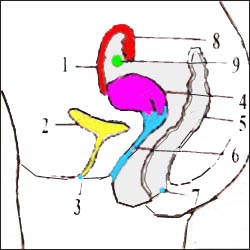
여성 생식기
1-난관, 2-방광, 3-외요도구, 4-자궁체, 5-직장
6-질, 7-항문, 8-나팔관, 9-난소
![]()

배란
![]()
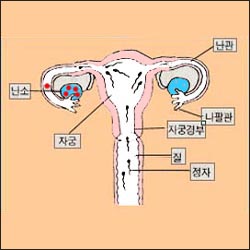
질강 속에 사정된 정자
![]()
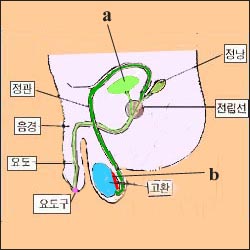
남성 생식기
a-방광, b-부고환
![]()
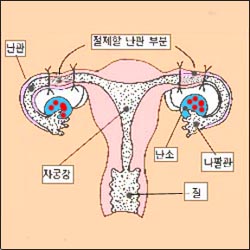
난관절제 수술 불임
![]()
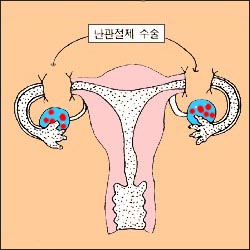
난관절제 수술 불임
![]()
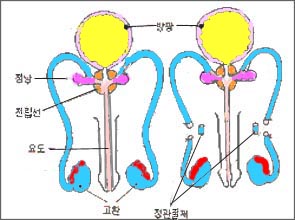
정관절제 수술로 불임한다
![]()
|
여자의 양쪽 난관의 일부를 수술로 절제해서 피임하는 것을 난관 결찰(난관절제) 피임수술이라고 한다. 남자의 양쪽 정관의 일부를 수술로 절제해서 피임하는 것을 정관 결찰(정관절제) 피임수술이라고 한다 여러 종류의 피임방법들 중 수술로 피임할 때의 피임효과가 가장 좋다. 그렇지만, 수술로 피임한 후 또다시 임신을 원할 때는 피임수술한 부위를 복구수술을 해야 한다. 그러므로 수술로 피임을 하기 전에 수술피임을 꼭 해야 하는지를 신중히 고려해야 한다. 난소에서 나온 난자가 난관을 통과하여 자궁 속으로 들어갈 수 없도록 양쪽 난관의 일부를 절제해 버리고 자궁 양쪽에 붙어 있는 나머지 난관 끝 부위와 난소 쪽에 붙어 있는 나머지 난관 끝 부위가 서로 연결되지 않게 수술실로 잡아매서 난자와 정자가 더 이상 만날 수 없다. 사정된 정자가 자궁 속과 결찰된 난관까지는 들어 갈 수 있으나 난소에서 나온 난자는 결찰된 난관까지만 들어갈 수 있고 정자를 만날 수 없기 때문에 불임된다. 복벽의 일부를 조금 째고 양쪽 난관의 일부를 절제해서 난관절제 수술로 피임하든지, 텔레스코프가 달린 의료기구를 복강 내에 집어넣고 양쪽 난관의 일부를 절제하여 난관절제 수술로 피임할 수 있다. 또 질강을 통해서도 난관절제 수술을 할 수 있다. 제왕절개 수술분만이나 다른 어떤 이유로 복강내 수술을 할 때 난관절제 수술도 동시에 해서 피임할 수 있다. 고환에서 정낭까지 연결된 가느다란 관을 정관이라고 한다. 고환에서 만들어진 정자는 정관 → 정낭 → 음경을 통하여 음경 밖으로 사정된다. 양쪽 정관의 일부를 절제하여 피임시키는 수술을 정관절제 수술이라고 한다. 정관절제 수술로 피임한 후에도 고환은 정자를 계속 생성할 수 있으나 정자는 수술을 받은 정관 부위까지만 도달할 수 있지 정낭 속으로 들어가지 못한다. 따라서 성교 중 정액을 질 속에 사정할 수는 있지만 그 정액 속에는 정자가 들어 있지 않다. 음경도 정상적으로 발기되고 성감에도 변화가 없다. 그리고 정액의 양도 정관절제 수술을 받지 않은 때와 같다. 정관절제 수술을 받은 후 2∼4개월까지 수술 받기 전 고환에서 배출된 정자가 정관이나 정낭 속에 있을 수 있다. 이 경우 정관절제 수술을 받은 후 약 2∼4개월까지 성교를 하면 임신될 수 있다. 따라서 정관절제 수술을 받은 후 적어도 2∼4개월까지는 다른 피임방법으로 피임해야 완전히 피임될 수 있다. 정관절제 수술 피임효과는 거의 100%이다. 정관절제 수술은 비교적 간단한 수술이지만, 정관수술로 피임한 후 또다시 자녀를 갖고 싶을 때는 수술로 절제한 정관의 양쪽 끝을 다시 연결시키는 정관복구 수술을 해야 한다. 이 수술은 상당히 힘든 수술에 속한다. 정관절제 수술이나 난관절제 수술로 피임하기 전 난관절제 수술이나 정관절제 수술로 피임할 것인지 충분히 고려한 후 수술로 피임해야 한다. Copyright ⓒ 2014 John Sangwon Lee, MD., FAAP
Infertility Surgery Vasectomy and tubal ligation 불임수술
Female genital organs 1-fallopian tubes, 2-bladder, 3-external ureter, 4-uterus, 5-rectum 6-vagina, 7-anal, 8-fallopian tube, 9-ovary ovulation Sperm ejaculated in the vaginal cavity
Male genitals a-bladder, b-epididymis Infertility with ocular joint surgery
Contraception by surgically resecting part of a woman’s two fallopian tubes is called fallopian tube ligation (egg joint preparation) contraceptive surgery.
Contraception is called a vas deferens ligation (vasectomy) contraceptive surgery by resecting part of a man’s vasectomy with surgery. Among the various types of contraception, the contraceptive effect when contraceptive by surgery is the best. However, if you want to become pregnant again after contraception through surgery, you must repair the area where the contraception was performed. Therefore, it is necessary to carefully consider whether or not surgical contraception is necessary before using surgical contraception. Part of both fallopian tubes is excised so that the egg from the ovary cannot pass through the fallopian tube and enter the uterus, and the rest of the fallopian tubes attached to both sides of the uterus and the rest of the fallopian tubes attached to the ovary are held in the operating room so that they are not connected to each other. The egg and sperm can no longer meet. The ejaculated sperm can enter the uterus and the ligated fallopian tube, but the egg from the ovary can only enter the ligated fallopian tube and is infertile because it cannot meet the sperm. The abdominal wall is partially cut off and part of both fallopian tubes is excised and contraceptives can be performed with fallopian joint surgery, or a medical device with a telescope is inserted into the abdominal cavity and parts of both fallopian tubes are excised and contraception can be performed with fallopian joint surgery. It is also possible to perform an oviduct surgery through the vaginal cavity. When performing intraperitoneal surgery for cesarean delivery or for any other reason, the fallopian joint surgery can also be performed at the same time as contraception. The slender tube connected from the testicles to the seminal vesicles is called the vas deferens. The sperm made in the testicle is ejaculated out of the penis through the vas deferens → seminal vesicle → penis. The surgery in which a part of both vas deferens are excised and contracepted is called a vas deferens surgery. The testes can continue to produce sperm even after contraception through a vasectomy, but the sperm can only reach the area of the vas deferens where the surgery was performed, but cannot enter the seminal vesicles. Therefore, it is possible to ejaculate the semen in the vagina during intercourse, but the semen does not contain sperm. The penis is also erected normally and there is no change in sexual sensation. And the amount of semen is the same as when he did not undergo varicose joint surgery. The sperm discharged from the testis before the surgery for 2 to 4 months after receiving a vasectomy may be in the vas deferens or seminal vesicles. In this case, you can become pregnant if you have sexual intercourse until about 2 to 4 months after receiving a varicose joint surgery. Therefore, at least 2 to 4 months after receiving a vasectomy, contraception can be completely contracepted by using another method of contraception. The contraceptive effect of varicose joint surgery is almost 100%. The vasectomy is a relatively simple operation, but if you want to have a child again after contraception through vasectomy, you need to perform a vasectomy to reconnect both ends of the vasectomy that was resected by surgery. This operation is a very difficult operation. Before contraception through a vas deferens surgery or a paroxysmal joint surgery, it is necessary to fully consider whether to use the contraception through a paroxysmal joint surgery or a vas deferens surgery. Copyright ⓒ 2014 John Sangwon Lee, MD., FAAP “부모도 반의사가 되어야 한다”-본 사이트의 내용은 여러분들의 의사로부터 얻은 정보와 진료를 대신할 수 없습니다. “The information contained in this publication should not be used as a substitute for the medical care and advice of your doctor. There may be variations in treatment that your doctor may recommend based on individual facts and circumstances. “Parental education is the best medicine.“ |